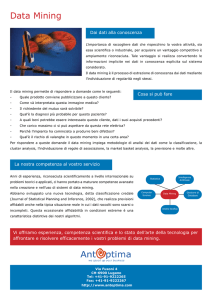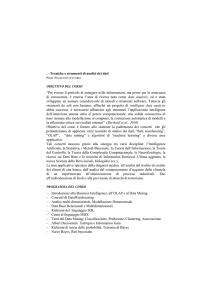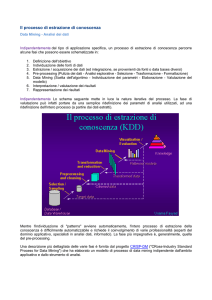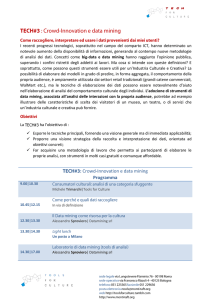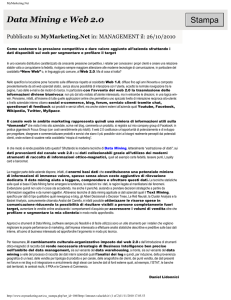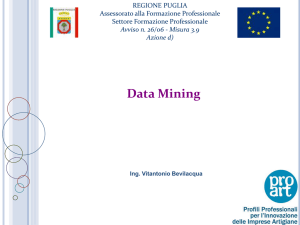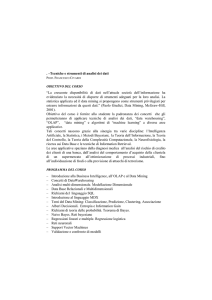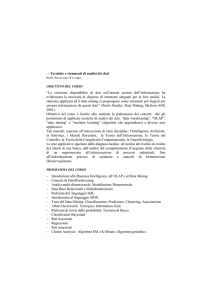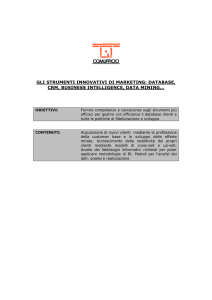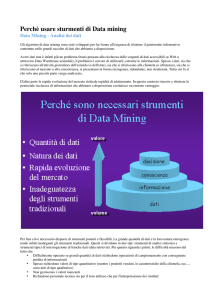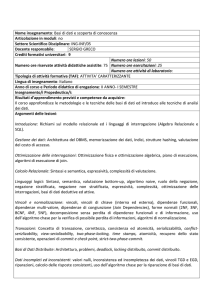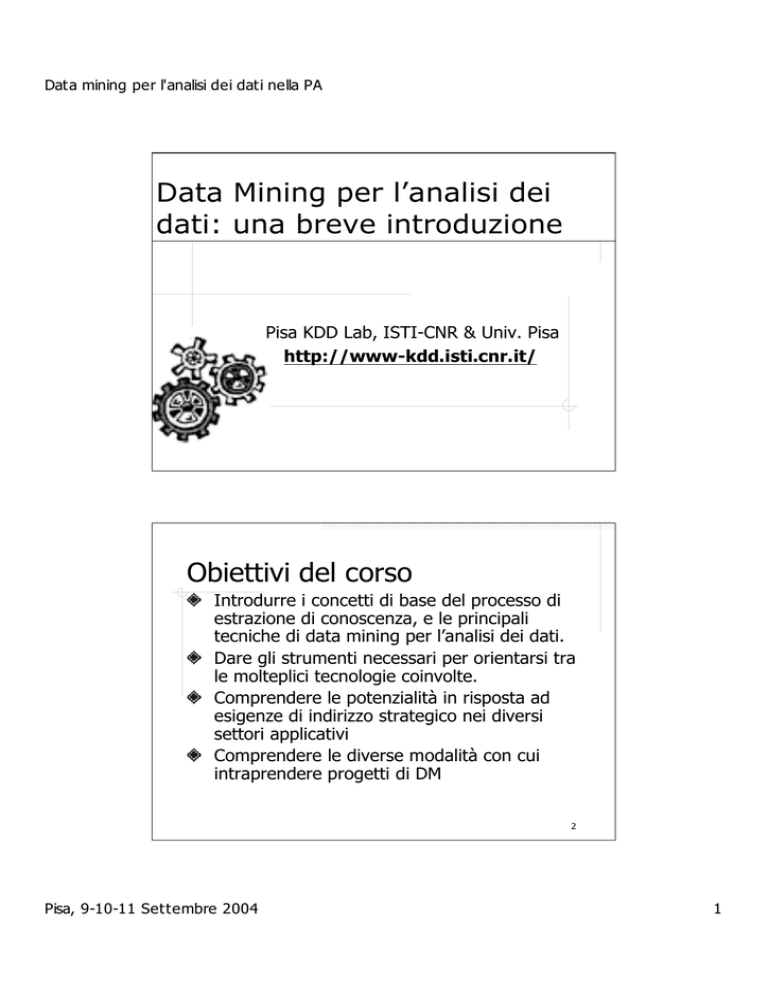
Data mining per l'analisi dei dati nella PA
Data Mining per l’analisi dei
dati: una breve introduzione
Pisa KDD Lab, ISTI-CNR & Univ. Pisa
http://www-kdd.isti.cnr.it/
Obiettivi del corso
Introdurre i concetti di base del processo di
estrazione di conoscenza, e le principali
tecniche di data mining per l’analisi dei dati.
Dare gli strumenti necessari per orientarsi tra
le molteplici tecnologie coinvolte.
Comprendere le potenzialità in risposta ad
esigenze di indirizzo strategico nei diversi
settori applicativi
Comprendere le diverse modalità con cui
intraprendere progetti di DM
2
Pisa, 9-10-11 Settembre 2004
1
Data mining per l'analisi dei dati nella PA
Esperienze di Formazione
KDD Lab ( http://www-kdd.isti.cnr.it ), centro di ricerca
congiunto fra Università di Pisa e ISTI–CNR, è stato uno dei
primi laboratori di ricerca europei focalizzato sul data mining;
ha organizzato fin dal 1998 vari interventi formativi:
Analisi dei dati aziendali mediante tecniche di data mining,
1998-1999 e 2000-2001, 2002-2003
in collaborazione con il Dipartimento di Statistica per l’Economia e
finanziato dalle province di Pisa e di Livorno
•
Tecniche di Data Mining:
Corso di Laurea Specialistica in Informatica, Univ. Pisa
•
Analisi di dati ed estrazione di conoscenza:
Corso di Laurea Specialistica in Informatica per l’Economia e
l’azienda, Univ. Pisa.
Laboratorio di Data Warehouse e Data Mining:
Corso di Laurea Specialistica in Informatica per l’Economia e
l’azienda, Univ. Pisa.
3
Struttura
Parte1 – Introduzione e concetti di base
Motivazioni, applicazioni, il processo KDD, le tecniche
Parte 2 – Comprensione e preparazione dei dati
Nozioni basiche di Datawarehouse
Analisi Multidimensionale ed OLAP
Parte 3 – La tecnologia data Mining
Regole Associative e Market Basket Analysis
Classificazione e regole predittive e Rilevazione di frodi
Clustering e Customer Segmentation
Demo di ambienti di Data Mining
Parte 4 – Data Mining per la PA: tendenze, esperienze e casi di
studio
Progetti di Data Mining nelle Università statunitensi
Mining Official Data
Mining for Health Care
4
Pisa, 9-10-11 Settembre 2004
2
Data mining per l'analisi dei dati nella PA
Seminar 1 – Introduction to DM
Motivations, applications,
the Knowledge Discovery in
Databases process,
the Data Mining techniques
Seminar 1 outline
Motivations
Application Areas
KDD Decisional Context
KDD Process
Architecture of a KDD system
The KDD steps in short
4 Examples in short
6
Pisa, 9-10-11 Settembre 2004
3
Data mining per l'analisi dei dati nella PA
Evolution of Database Technology:
from data management to data analysis
1960s:
Data collection, database creation, IMS and network DBMS.
1970s:
Relational data model, relational DBMS implementation.
1980s:
RDBMS, advanced data models (extended-relational, OO,
deductive, etc.) and application-oriented DBMS (spatial,
scientific, engineering, etc.).
1990s:
Data mining and data warehousing, multimedia databases, and
Web technology.
7
What Is Data Mining?
Data mining (knowledge discovery from data)
Extraction of interesting (non-trivial, implicit, previously unknown and
potentially useful) patterns or knowledge from huge amount of data
Data mining: a misnomer?
Alternative names
Knowledge discovery (mining) in databases (KDD), knowledge
extraction, data/pattern analysis, data archeology, data dredging,
information harvesting, business intelligence, etc.
Watch out: Is everything “data mining”?
(Deductive) query processing.
Expert systems or small ML/statistical programs
8
Pisa, 9-10-11 Settembre 2004
4
Data mining per l'analisi dei dati nella PA
Why Data Mining
Increased Availability of Huge Amounts of Data
point-of-sale customer data
digitization of text, images, video, voice, etc.
World Wide Web and Online collections
Data Too Large or Complex for Classical or
Manual Analysis
number of records in millions or billions
high dimensional data (too many fields/features/attributes)
often too sparse for rudimentary observations
high rate of growth (e.g., through logging or automatic data
collection)
heterogeneous data sources
Business Necessity
e-commerce
high degree of competition
personalization, customer loyalty, market segmentation
9
Motivations
“Necessity is the Mother of Invention”
Data explosion problem:
Automated data collection tools, mature database
technology and internet lead to tremendous amounts of
data stored in databases, data warehouses and other
information repositories.
We are drowning in information, but starving for
knowledge! (John Naisbett)
Data warehousing and data mining :
On-line analytical processing
Extraction of interesting knowledge (rules, regularities,
patterns, constraints) from data in large databases.
10
Pisa, 9-10-11 Settembre 2004
5
Data mining per l'analisi dei dati nella PA
Motivations for DM
Abundance of business and industry data
Competitive focus - Knowledge Management
Inexpensive, powerful computing engines
Strong theoretical/mathematical foundations
machine learning & artificial intelligence
statistics
database management systems
11
Data Mining: Confluence of
Multiple Disciplines
Database
Technology
Machine
Learning (AI)
Information
Science
Statistics
Data Mining
Visualization
Other
Disciplines
12
Pisa, 9-10-11 Settembre 2004
6
Data mining per l'analisi dei dati nella PA
Sources of Data
Business Transactions
widespread use of bar codes => storage of millions of
transactions daily (e.g., Walmart: 2000 stores => 20M
transactions per day)
most important problem: effective use of the data in a
reasonable time frame for competitive decision-making
e-commerce data
Scientific Data
data generated through multitude of experiments and
observations
examples, geological data, satellite imaging data, NASA earth
observations
rate of data collection far exceeds the speed by which we
analyze the data
13
Sources of Data
Financial Data
company information
economic data (GNP, price indexes, etc.)
stock markets
Personal / Statistical Data
government census
medical histories
customer profiles
demographic data
data and statistics about sports and athletes
14
Pisa, 9-10-11 Settembre 2004
7
Data mining per l'analisi dei dati nella PA
Sources of Data
World Wide Web and Online Repositories
email, news, messages
Web documents, images, video, etc.
link structure of of the hypertext from millions of
Web sites
Web usage data (from server logs, network
traffic, and user registrations)
online databases, and digital libraries
15
Classes of applications
Database analysis and decision support
Market analysis
Risk analysis
target marketing, customer relation management, market
basket analysis, cross selling, market segmentation.
Forecasting, customer retention, improved underwriting,
quality control, competitive analysis.
Fraud detection
New Applications from New sources of data
Text (news group, email, documents)
Web analysis and intelligent search
16
Pisa, 9-10-11 Settembre 2004
8
Data mining per l'analisi dei dati nella PA
Market Analysis
Where are the data sources for analysis?
Credit card transactions, loyalty cards, discount
coupons, customer complaint calls, plus (public) lifestyle
studies.
Target marketing
Find clusters of “model” customers who share the same
characteristics: interest, income level, spending habits,
etc.
Determine customer purchasing patterns over time
Conversion of single to a joint bank account: marriage,
etc.
Cross-market analysis
Associations/co-relations between product sales
Prediction based on the association information.
17
Market Analysis (2)
Customer profiling
data mining can tell you what types of customers
buy what products (clustering or classification).
Identifying customer requirements
identifying the best products for different customers
use prediction to find what factors will attract new
customers
Summary information
various multidimensional summary reports;
statistical summary information (data central
tendency and variation)
Pisa, 9-10-11 Settembre 2004
18
9
Data mining per l'analisi dei dati nella PA
Risk Analysis
Finance planning and asset evaluation:
cash flow analysis and prediction
contingent claim analysis to evaluate assets
trend analysis
Resource planning:
summarize and compare the resources and spending
Competition:
monitor competitors and market directions (CI:
competitive intelligence).
group customers into classes and class-based pricing
procedures
set pricing strategy in a highly competitive market
19
Fraud Detection
Applications:
widely used in health care, retail, credit card services,
telecommunications (phone card fraud), etc.
Approach:
use historical data to build models of fraudulent
behavior and use data mining to help identify similar
instances.
Examples:
auto insurance: detect a group of people who stage
accidents to collect on insurance
money laundering: detect suspicious money
transactions (US Treasury's Financial Crimes
Enforcement Network)
20
medical insurance: detect professional patients and ring
of doctors and ring of references
Pisa, 9-10-11 Settembre 2004
10
Data mining per l'analisi dei dati nella PA
Fraud Detection (2)
More examples:
Detecting inappropriate medical treatment:
Australian Health Insurance Commission identifies
that in many cases blanket screening tests were
requested (save Australian $1m/yr).
Detecting telephone fraud:
Telephone call model: destination of the call,
duration, time of day or week. Analyze patterns that
deviate from an expected norm.
Retail: Analysts estimate that 38% of retail
shrink is due to dishonest employees.
21
Other applications
Sports
IBM Advanced Scout analyzed NBA game statistics
(shots blocked, assists, and fouls) to gain competitive
advantage for New York Knicks and Miami Heat.
Astronomy
JPL and the Palomar Observatory discovered 22
quasars with the help of data mining
Internet Web Surf-Aid
IBM Surf-Aid applies data mining algorithms to Web
access logs for market-related pages to discover
customer preference and behavior pages, analyzing
effectiveness of Web marketing, improving Web site
organization, etc.
22
Pisa, 9-10-11 Settembre 2004
11
Data mining per l'analisi dei dati nella PA
What is Knowledge Discovery in
Databases (KDD)? A process!
The selection and processing of data for:
the identification of novel, accurate, and
useful patterns, and
the modeling of real-world phenomena.
Data mining is a major component of the
KDD process - automated discovery of
patterns and the development of predictive
and explanatory models.
23
The KDD process
Interpretation
and Evaluation
Data Mining
Knowledge
Selection and
Preprocessing
Data
Consolidation
p(x)=0.02
Patterns &
Models
Warehouse
Prepared Data
Consolidated
Data
Data Sources
Pisa, 9-10-11 Settembre 2004
24
12
Data mining per l'analisi dei dati nella PA
The KDD Process in Practice
KDD is an Iterative Process
art + engineering rather than science
25
The steps of the KDD process
Learning the application domain:
relevant prior knowledge and goals of application
Data consolidation: Creating a target data set
Selection and Preprocessing
Data cleaning : (may take 60% of effort!)
Data reduction and projection:
find useful features, dimensionality/variable reduction, invariant representation.
Choosing functions of data mining
summarization, classification, regression, association, clustering.
Choosing the mining algorithm(s)
Data mining: search for patterns of interest
Interpretation and evaluation: analysis of results.
visualization, transformation, removing redundant patterns, …
Use of discovered knowledge
26
Pisa, 9-10-11 Settembre 2004
13
Data mining per l'analisi dei dati nella PA
The virtuous cycle
Knowledge
Problem
Identify
Problem or
Opportunity
Strategy
Act on
Knowledge
Measure effect
of Action
Results
27
Data mining and business
intelligence
Increasing potential
to support
business decisions
Making
Decisions
Data Presentation
Visualization Techniques
Data Mining
Information Discovery
End User
Business
Analyst
Data
Analyst
Data
Statistical Analysis,
Querying and Reporting
Exploration
Data Warehouses / Data Marts
OLAP, MDA
Data Sources
Paper, Files, Information Providers, Database Systems, OLTP
DBA
28
Pisa, 9-10-11 Settembre 2004
14
Data mining per l'analisi dei dati nella PA
Roles in the KDD process
29
A business intelligence
environment
30
Pisa, 9-10-11 Settembre 2004
15
Data mining per l'analisi dei dati nella PA
The KDD process
Interpretation
and Evaluation
Data Mining
Knowledge
Selection and
Preprocessing
p(x)=0.02
Data
Consolidation
Warehouse
Patterns &
Models
Prepared Data
Consolidated
Data
Data Sources
31
Data consolidation and
preparation
Garbage in
Garbage out
The quality of results relates directly to
quality of the data
50%-70% of KDD process effort is spent on
data consolidation and preparation
Major justification for a corporate data
warehouse
32
Pisa, 9-10-11 Settembre 2004
16
Data mining per l'analisi dei dati nella PA
Data consolidation
RDBMS
From data sources to consolidated data
repository
Data
Consolidation
and Cleansing
Legacy
DBMS
Flat Files
External
Warehouse
Object/Relation DBMS
Multidimensional DBMS
Deductive Database
Flat files
33
Data consolidation
Determine preliminary list of attributes
Consolidate data into working database
Internal and External sources
Eliminate or estimate missing values
Remove outliers (obvious exceptions)
Determine prior probabilities of categories
and deal with volume bias
34
Pisa, 9-10-11 Settembre 2004
17
Data mining per l'analisi dei dati nella PA
The KDD process
Interpretation
and Evaluation
Data Mining
Selection and
Preprocessing
Knowledge
p(x)=0.02
Data
Consolidation
Warehouse
35
Data selection and preprocessing
Generate a set of examples
choose sampling method
consider sample complexity
deal with volume bias issues
Reduce attribute dimensionality
remove redundant and/or correlating attributes
combine attributes (sum, multiply, difference)
Reduce attribute value ranges
group symbolic discrete values
quantify continuous numeric values
Transform data
de-correlate and normalize values
map time-series data to static representation
OLAP and visualization tools play key role
Pisa, 9-10-11 Settembre 2004
36
18
Data mining per l'analisi dei dati nella PA
The KDD process
Interpretation
and Evaluation
Data Mining
Knowledge
Selection and
Preprocessing
p(x)=0.02
Data
Consolidation
Warehouse
37
Data mining tasks and
methods
Directed Knowledge Discovery
Purpose: Explain value of some field in terms
of all the others (goal-oriented)
Method: select the target field based on some
hypothesis about the data; ask the algorithm
to tell us how to predict or classify new
instances
Examples:
what products show increased sale when
cream cheese is discounted
which banner ad to use on a web page for a
given user coming to the site
38
Pisa, 9-10-11 Settembre 2004
19
Data mining per l'analisi dei dati nella PA
Data mining tasks and
methods
Undirected Knowledge Discovery
(Explorative Methods)
Purpose: Find patterns in the data that may be
interesting (no target specified)
Method: clustering, association rules (affinity
grouping)
Examples:
which products in the catalog often sell
together
market segmentation (groups of
customers/users with similar characteristics)
39
Data Mining Models
Automated Exploration/Discovery
x2
e.g.. discovering new market segments
clustering analysis
x1
Prediction/Classification
e.g.. forecasting gross sales given current factors
regression, neural networks, genetic algorithms,
decision trees
Explanation/Description
e.g.. characterizing customers by demographics
purchase history
if age > 35
decision trees, association rules
f(x)
and
x
and income < $35k
then ...
40
Pisa, 9-10-11 Settembre 2004
20
Data mining per l'analisi dei dati nella PA
Automated exploration and
discovery
Clustering: partitioning a set of data into a set of
classes, called clusters, whose members share some
interesting common properties.
Distance-based numerical clustering
metric grouping of examples (K-NN)
graphical visualization can be used
Bayesian clustering
search for the number of classes which result in
best fit of a probability distribution to the data
AutoClass (NASA) one of best examples
41
Prediction and classification
Learning a predictive model
Classification of a new case/sample
Many methods:
Artificial neural networks
Inductive decision tree and rule systems
Genetic algorithms
Nearest neighbor clustering algorithms
Statistical (parametric, and non-parametric)
42
Pisa, 9-10-11 Settembre 2004
21
Data mining per l'analisi dei dati nella PA
Generalization and regression
The objective of learning is to achieve good
generalization to new unseen cases.
Generalization can be defined as a
mathematical interpolation or regression
over a set of training points
Models can be validated with a previously
unseen test set or using cross-validation
methods
f(x)
x
43
Classification and prediction
Classify data based on the values of a
target attribute, e.g., classify countries
based on climate, or classify cars based on
gas mileage.
Use obtained model to predict some
unknown or missing attribute values based
on other information.
44
Pisa, 9-10-11 Settembre 2004
22
Data mining per l'analisi dei dati nella PA
inductive modeling = learning
Objective: Develop a general model or
hypothesis from specific
examples
f(x)
Function approximation (curve fitting)
x
Classification (concept learning, pattern
A
recognition)
x2
B
x1 45
Explanation and description
(MOBASHER RULES)
Learn a generalized hypothesis (model) from
selected data
Description/Interpretation of model provides
new knowledge
Affinity Grouping
Methods:
Inductive decision tree and rule systems
Association rule systems
Link Analysis
…
46
Pisa, 9-10-11 Settembre 2004
23
Data mining per l'analisi dei dati nella PA
Affinity Grouping
Determine what items often go together (usually in
transactional databases)
Often Referred to as Market Basket Analysis
used in retail for planning arrangement on shelves
used for identifying cross-selling opportunities
“should” be used to determine best link structure for a Web
site
Examples
people who buy milk and beer also tend to buy diapers
people who access pages A and B are likely to place an online
order
Suitable data mining tools
association rule discovery
clustering
Nearest Neighbor analysis (memory-based reasoning)
47
Exception/deviation detection
Generate a model of normal activity
Deviation from model causes alert
Methods:
Artificial neural networks
Inductive decision tree and rule systems
Statistical methods
Visualization tools
48
Pisa, 9-10-11 Settembre 2004
24
Data mining per l'analisi dei dati nella PA
Outlier and exception data
analysis
Time-series analysis (trend and deviation):
Trend and deviation analysis: regression,
sequential pattern, similar sequences,
trend and deviation, e.g., stock analysis.
Similarity-based pattern-directed analysis
Full vs. partial periodicity analysis
Other pattern-directed or statistical analysis
49
The KDD process
Interpretation
and Evaluation
Data Mining
Knowledge
Selection and
Preprocessing
p(x)=0.02
Data Consolidation
and Warehousing
Warehouse
50
Pisa, 9-10-11 Settembre 2004
25
Data mining per l'analisi dei dati nella PA
Are all the discovered pattern
interesting?
A data mining system/query may generate thousands of
patterns, not all of them are interesting.
Interestingness measures:
easily understood by humans
valid on new or test data with some degree of certainty.
potentially useful
novel, or validates some hypothesis that a user seeks to confirm
Objective vs. subjective interestingness measures
Objective: based on statistics and structures of patterns, e.g.,
support, confidence, etc.
Subjective: based on user’s beliefs in the data, e.g.,
unexpectedness, novelty, etc.
51
Interpretation and evaluation
Evaluation
Statistical validation and significance testing
Qualitative review by experts in the field
Pilot surveys to evaluate model accuracy
Interpretation
Inductive tree and rule models can be read
directly
Clustering results can be graphed and tabled
Code can be automatically generated by
some systems (IDTs, Regression models)
52
Pisa, 9-10-11 Settembre 2004
26
Data mining per l'analisi dei dati nella PA
Why Data Mining Query Language?
Automated vs. query-driven?
Finding all the patterns autonomously in a
database?—unrealistic because the patterns could be
too many but uninteresting
Data mining should be an interactive process
User directs what to be mined
Users must be provided with a set of primitives
to be used to communicate with the data mining
system
Incorporating these primitives in a data mining
query language
Standardization of data mining industry and
53
practice
Primitives that Define a Data Mining Task
Task-relevant data
Type of knowledge to be mined
Background knowledge
Pattern interestingness measurements
Visualization/presentation of discovered
patterns
Pisa, 9-10-11 Settembre 2004
54
27
Data mining per l'analisi dei dati nella PA
Primitive 1: Task-Relevant
Data
Database or data warehouse name
Database tables or data warehouse cubes
Condition for data selection
Relevant attributes or dimensions
Data grouping criteria
55
Primitive 2: Types of Knowledge to Be
Mined
Characterization
Discrimination
Association
Classification/prediction
Clustering
Outlier analysis
Other data mining tasks
56
Pisa, 9-10-11 Settembre 2004
28
Data mining per l'analisi dei dati nella PA
Primitive 3: Background Knowledge (Concept
Hierarchies)
Schema hierarchy
E.g., street < city < province_or_state < country
Set-grouping hierarchy
E.g., {20-39} = young, {40-59} = middle_aged
Operation-derived hierarchy
email address: [email protected]
login-name < department < university < country
Rule-based hierarchy
low_profit_margin (X) <= price(X, P1) and cost
(X, P2) and (P1 - P2) < $50
57
Primitive 4: Measurements of Pattern
Interestingness
Simplicity
e.g., (association) rule length, (decision) tree size
Certainty
e.g., confidence, P(A|B) = #(A and B)/ #(B),
classification reliability, etc.
Utility
potential usefulness, e.g., support (association), noise
threshold (description)
Novelty
not previously known, surprising (used to remove
redundant rules, e.g., Bill Clinton vs. William Clinton)
58
Pisa, 9-10-11 Settembre 2004
29
Data mining per l'analisi dei dati nella PA
Primitive 5: Presentation of Discovered
Patterns
Different backgrounds/usages may require different
forms of representation
E.g., rules, tables, pie/bar chart, etc.
Concept hierarchy is also important
Discovered knowledge might be more understandable
when represented at high level of abstraction
Interactive drill up/down, pivoting, slicing and dicing
provide different perspectives to data
Different kinds of knowledge require different
representation: association, classification, clustering, etc.
59
DMQL—A Data Mining Query
Language
Motivation
A DMQL can provide the ability to support adhoc and interactive data mining
By providing a standardized language like SQL
Hope to achieve a similar effect like that SQL has on
relational database
Foundation for system development and evolution
Facilitate information exchange, technology transfer,
commercialization and wide acceptance
Design
DMQL is designed with the primitives
described earlier
Pisa, 9-10-11 Settembre 2004
60
30
Data mining per l'analisi dei dati nella PA
An Example Query in DMQL
61
Other Data Mining Languages &
Standardization Efforts
Association rule language specifications
MSQL (Imielinski & Virmani’99)
MineRule (Meo Psaila and Ceri’96)
Query flocks based on Datalog syntax (Tsur et al’98)
OLEDB for DM (Microsoft’2000) and recently DMX
(Microsoft SQLServer 2005)
Based on OLE, OLE DB, OLE DB for OLAP, C#
Integrating DBMS, data warehouse and data mining
DMML (Data Mining Mark-up Language) by DMG
(www.dmg.org)
62
Pisa, 9-10-11 Settembre 2004
31
Data mining per l'analisi dei dati nella PA
Integration of Data Mining and Data
Warehousing
Data mining systems, DBMS, Data warehouse
systems coupling
On-line analytical mining data
integration of mining and OLAP technologies
Interactive mining multi-level knowledge
Necessity of mining knowledge and patterns at
different levels of abstraction.
Integration of multiple mining functions
Characterized classification, first clustering and then
63
association
Architecture: Typical Data Mining
System
Graphical User Interface
Pattern Evaluation
Data Mining Engine
Knowl
edgeBase
Database or Data
Warehouse Server
data cleaning, integration, and selection
Database
Data
World-Wide Other Info
Repositories
Warehouse
Web
64
Pisa, 9-10-11 Settembre 2004
32
Data mining per l'analisi dei dati nella PA
Seminar 1 - Bibliography
Jiawei Han, Micheline Kamber, Data
Mining: Concepts and Techniques,
Morgan Kaufmann Publishers, 2000
Micheael, J. A. Berry, Gordon S.
Linoff, Mastering Data Mining, Wiley,
2000
Klosgen, Zytkow, Handbook of Data
Mining, Oxford, 2001
65
Seminar 1 - Bibliography
Jiawei Han, Micheline Kamber, Data Mining: Concepts
and Techniques, Morgan Kaufmann Publishers, 2000
http://www.mkp.com/books_catalog/catalog.asp?ISBN=1
-55860-489-8
• U. Fayyad, G. Piatetsky-Shapiro, P. Smyth, R.
Uthurusamy (editors). Advances in Knowledge
discovery and data mining, MIT Press, 1996.
• David J. Hand, Heikki Mannila, Padhraic Smyth,
Principles of Data Mining, MIT Press, 2001.
• S. Chakrabarti, Mining the Web: Discovering Knowledge
from Hypertext Data, Morgan Kaufmann, ISBN 1-55860754-4, 2002
66
Pisa, 9-10-11 Settembre 2004
33
Data mining per l'analisi dei dati nella PA
Examples of DM projects
Competitive Intelligence
Fraud Detection,
Health care,
Traffic Accident Analysis,
Moviegoers database: a
simple example at work
L’Oreal, a case-study on
competitive intelligence:
Source: DM@CINECA
http://open.cineca.it/datamining/dmCineca/
Pisa, 9-10-11 Settembre 2004
34
Data mining per l'analisi dei dati nella PA
A small example
Domain: technology watch - a.k.a.
competitive intelligence
Which are the emergent technologies?
Which competitors are investing on them?
In which area are my competitors active?
Which area will my competitor drop in the near
future?
Source of data:
public (on-line) databases
69
The Derwent database
Contains all patents filed worldwide in last 10
years
Searching this database by keywords may
yield thousands of documents
Derwent document are semi-structured:
many long text fields
Goal: analyze Derwent document to build a
model of competitors’ strategy
70
Pisa, 9-10-11 Settembre 2004
35
Data mining per l'analisi dei dati nella PA
Structure of Derwent
documents
71
Example dataset
Patents in the area: patch technology
(cerotto medicale)
105 companies from 12 countries
94 classification codes
52 Derwent codes
72
Pisa, 9-10-11 Settembre 2004
36
Data mining per l'analisi dei dati nella PA
Clustering output
73
Zoom on cluster 2
74
Pisa, 9-10-11 Settembre 2004
37
Data mining per l'analisi dei dati nella PA
Zoom on cluster 2 - profiling
competitors
75
Activity of competitors in the clusters
76
Pisa, 9-10-11 Settembre 2004
38
Data mining per l'analisi dei dati nella PA
Temporal analysis of clusters
77
Fraud detection and audit
planning
Source: Ministero delle Finanze
Progetto Sogei, KDD Lab. Pisa
Pisa, 9-10-11 Settembre 2004
39
Data mining per l'analisi dei dati nella PA
Fraud detection
A major task in fraud detection is
constructing models of fraudulent behavior,
for:
preventing future frauds (on-line fraud detection)
discovering past frauds (a posteriori fraud
detection)
analyze historical audit data to plan effective
future audits
79
Audit planning
Need to face a trade-off between
conflicting issues:
maximize audit benefits: select subjects to
be audited to maximize the recovery of
evaded tax
minimize audit costs: select subjects to be
audited to minimize the resources needed
to carry out the audits.
80
Pisa, 9-10-11 Settembre 2004
40
Data mining per l'analisi dei dati nella PA
Available data sources
Dataset: tax declarations, concerning a
targeted class of Italian companies, integrated
with other sources:
social benefits to employees, official
documents, electricity and telephone bills.
budget
Size: 80 K tuples, 175 numeric attributes.
A subset of 4 K tuples corresponds to the
audited companies:
outcome of audits recorded as the recovery attribute
(= amount of evaded tax ascertained )
81
Data preparation
original
dataset
81 K
data consolidation
data cleaning
attribute selection
audit
outcomes
4 K
82
Pisa, 9-10-11 Settembre 2004
41
Data mining per l'analisi dei dati nella PA
Cost model
A derived attribute audit_cost is defined
as a function of other attributes
f
audit_cost
83
Cost model and the target
variable
recovery of an audit after the audit cost
actual_recovery = recovery - audit_cost
target variable (class label) of our analysis is
set as the Class of Actual Recovery (c.a.r.):
c.a.r. =
negative
if actual_recovery ≤ 0
positive
if actual_recovery > 0.
84
Pisa, 9-10-11 Settembre 2004
42
Data mining per l'analisi dei dati nella PA
Quality assessment indicators
The obtained classifiers are evaluated
according to several indicators, or metrics
Domain-independent indicators
confusion matrix
misclassification rate
Domain-dependent indicators
audit #
actual recovery
profitability
relevance
85
Domain-dependent quality
indicators
audit # (of a given classifier): number of
tuples classified as positive =
# (FP ∪ TP)
actual recovery: total amount of actual
recovery for all tuples classified as positive
profitability: average actual recovery per
audit
relevance: ratio between profitability and
misclassification rate
86
Pisa, 9-10-11 Settembre 2004
43
Data mining per l'analisi dei dati nella PA
The REAL case
Classifiers can be compared with the
REAL case, consisting of the whole testset:
audit # (REAL) = 366
actual recovery(REAL) = 159.6 M euro
87
Model evaluation: classifier 1
(min FP)
no replication in training-set (unbalance towards negative)
10-trees adaptive boosting
misc. rate = 22%
audit # = 59 (11 FP)
actual rec.= 141.7 Meuro
profitability = 2.401
88
Pisa, 9-10-11 Settembre 2004
44
Data mining per l'analisi dei dati nella PA
Model evaluation: classifier 2
(min FN)
replication in training-set (balanced neg/pos)
misc. weights (trade 3 FP for 1 FN)
3-trees adaptive boosting
misc. rate = 34%
audit # = 188 (98 FP)
actual rec.= 165.2 Meuro
profitability = 0.878
89
Atherosclerosis prevention
study
2nd Department of Medicine, 1st Faculty of
Medicine of Charles University and Charles
University Hospital, U nemocnice 2, Prague 2
(head. Prof. M. Aschermann, MD, SDr, FESC)
Pisa, 9-10-11 Settembre 2004
45
Data mining per l'analisi dei dati nella PA
Atherosclerosis prevention
study:
The STULONG 1 data set is a real
database that keeps information about
the study of the development of
atherosclerosis risk factors in a
population of middle aged men.
Used for Discovery Challenge at PKDD
00-02-03-04
91
Atherosclerosis prevention
study:
Study on 1400 middle-aged men at Czech
hospitals
Measurements concern development of
cardiovascular disease and other health data in a
series of exams
The aim of this analysis is to look for
associations between medical characteristics
of patients and death causes.
Four tables
Entry and subsequent exams, questionnaire
responses, deaths
92
Pisa, 9-10-11 Settembre 2004
46
Data mining per l'analisi dei dati nella PA
The input data
Data from Entry and Exams
General characteristics
Examinations
habits
Marital status
Transport to a job
Physical activity in a job
Activity after a job
Education
Responsibility
Age
Weight
Height
Chest pain
Breathlesness
Cholesterol
Urine
Subscapular
Triceps
Alcohol
Liquors
Beer 10
Beer 12
Wine
Smoking
Former smoker
Duration of smoking
Tea
Sugar
Coffee
93
The input data
DEATH CAUSE
PATIENTS
%
myocardial infarction
80
20.6
coronary heart disease
33
8.5
stroke
30
7.7
other causes
79
20.3
sudden death
23
5.9
8
2.0
114
29.3
22
5.7
389
100.0
unknown
tumorous disease
general atherosclerosis
TOTAL
94
Pisa, 9-10-11 Settembre 2004
47
Data mining per l'analisi dei dati nella PA
Data selection
When joining “Entry” and “Death” tables we
implicitely create a new attribute “Cause of
death”, which is set to “alive” for subjects
present in the “Entry” table but not in the
“Death” table.
We have only 389 subjects in death table.
95
The prepared data
96
Pisa, 9-10-11 Settembre 2004
48
Data mining per l'analisi dei dati nella PA
Descriptive Analysis/ Subgroup
Discovery /Association Rules
Are there strong relations concerning death cause?
1. General characteristics (?) ⇒ Death cause (?)
2. Examinations (?) ⇒ Death cause (?)
3. Habits (?) ⇒ Death cause (?)
4. Combinations (?) ⇒ Death cause (?)
97
Example of extracted rules
Education(university) & Height<176180> ÞDeath cause (tumouros
disease), 16 ; 0.62
It means that on tumorous disease have
died 16, i.e. 62% of patients with university
education and with height 176-180 cm.
98
Pisa, 9-10-11 Settembre 2004
49
Data mining per l'analisi dei dati nella PA
Example of extracted rules
Physical activity in work(he mainly sits)
& Height<176-180> Þ Death cause
(tumouros disease), 24; 0.52
It means that on tumorous disease have
died 24 i.e. 52% of patients that mainly sit
in the work and whose height is 176-180
cm.
99
Example of extracted rules
Education(university) & Height<176-180>
ÞDeath cause (tumouros disease),
16; 0.62; +1.1;
the relative frequency of patients who died on
tumorous disease among patients with university
education and with height 176-180 cm is 110 per
cent higher than the relative frequency of patients
who died on tumorous disease among all the 389
observed patients
100
Pisa, 9-10-11 Settembre 2004
50
Data mining per l'analisi dei dati nella PA
Moviegoer Database :
102
Pisa, 9-10-11 Settembre 2004
51
Data mining per l'analisi dei dati nella PA
SELECT moviegoers.name, moviegoers.sex, moviegoers.age,
sources.source, movies.name
FROM movies, sources, moviegoers
WHERE sources.source_ID = moviegoers.source_ID AND
movies.movie_ID = moviegoers.movie_ID
ORDER BY moviegoers.name;
moviegoers.name
sex
age
source
movies.name
Amy
Andrew
Andy
Anne
Ansje
Beth
Bob
Brian
Candy
Cara
Cathy
Charles
Curt
David
Erica
f
m
m
f
f
f
m
m
f
f
f
m
m
m
f
27
25
34
30
25
30
51
23
29
25
39
25
30
40
23
Oberlin
Oberlin
Oberlin
Oberlin
Oberlin
Oberlin
Pinewoods
Oberlin
Oberlin
Oberlin
Mt. Auburn
Oberlin
MRJ
MRJ
Mt. Auburn
Independence Day
12 Monkeys
The Birdcage
Trainspotting
I Shot Andy Warhol
Chain Reaction
Schindler's List
Super Cop
Eddie
Phenomenon
The Birdcage
Kingpin
T2 Judgment Day
Independence Day
Trainspotting
103
Example: Moviegoer Database
Classification
determine sex based on age, source, and movies
seen
determine source based on sex, age, and movies
seen
determine most recent movie based on past
movies, age, sex, and source
Estimation
for predict, need a continuous variable (e.g., “age”)
predict age as a function of source, sex, and past
movies
if we had a “rating” field for each moviegoer, we
could predict the rating a new moviegoer gives to
a movie based on age, sex, past movies, etc.
104
Pisa, 9-10-11 Settembre 2004
52
Data mining per l'analisi dei dati nella PA
Example: Moviegoer Database
Clustering
find groupings of movies that are often seen by
the same people
find groupings of people that tend to see the
same movies
clustering might reveal relationships that are not
necessarily recorded in the data (e.g., we may
find a cluster that is dominated by people with
young children; or a cluster of movies that
correspond to a particular genre)
105
Example: Moviegoer Database
Association Rules
market basket analysis (MBA): “which movies go
together?”
need to create “transactions” for each moviegoer
containing movies seen by that moviegoer:
name
TID
Transaction
Amy
Andrew
Andy
Anne
…
001
002
003
004
…
{Independence Day, Trainspotting}
{12 Monkeys, The Birdcage, Trainspotting, Phenomenon}
{Super Cop, Independence Day, Kingpin}
{Trainspotting, Schindler's List}
...
may result in association rules such as:
{“Phenomenon”, “The Birdcage”} ==>
{“Trainspotting”}
{“Trainspotting”, “The Birdcage”} ==> {sex = “f”}
106
Pisa, 9-10-11 Settembre 2004
53
Data mining per l'analisi dei dati nella PA
Example: Moviegoer Database
Sequence Analysis
similar to MBA, but order in which items
appear in the pattern is important
e.g., people who rent “The Birdcage”
during a visit tend to rent “Trainspotting”
in the next visit.
107
On the road to knowledge: mining
21 years of UK traffic accident
reports
Peter Flach et al.
Silnet Network of Excellence
Pisa, 9-10-11 Settembre 2004
54
Data mining per l'analisi dei dati nella PA
Mining traffic accident reports
the Hampshire County Council (UK) wanted
to obtain a better insight into how the
characteristics of traffic accidents may have
changed over the past 20 years as a result of
improvements in highway design and in
vehicle design.
The database, contained police traffic
accident reports for all UK accidents that
happened in the period 1979-1999.
109
Business Understanding
Understanding of road safety in order to
reduce the occurrences and severity of
accidents.
influence of road surface condition;
influence of skidding;
influence of location (for example: junction approach);
and influence of street lighting.
trend analysis: long-term overall trends,
regional trends, urban trends, and rural
trends.
the comparison of different kinds of locations
is interesting: for example, rural versus
110
metropolitan versus suburban.
Pisa, 9-10-11 Settembre 2004
55
Data mining per l'analisi dei dati nella PA
Data understanding
Low data quality. Many attribute values
were missing or recorded as unknown.
Different maps were created to
investigate the effect of several
parameters like accident severity and
accident date.
111
Modelling
The aim of this effort was to find
interesting associations between road
number, conditions (e.g., weather, and
light) and serious or fatal accidents.
Certain localities had been selected
and performed the analysis only over
the years 1998 and 1999.
112
Pisa, 9-10-11 Settembre 2004
56
Data mining per l'analisi dei dati nella PA
Extracted rule
The relative frequency of fatal accidents
among all accidents in the locality was 3%.
The relative frequency of fatal accidents on
the road (V61) under fine weather with no
winds was 9.6% — more than 3 times
greater.
113
Seminar 1 Case studies Bibliography
Artif. Intell. Med. 2001 Jun;22(3), Special Issue on Data
Mining in Medicine
Klosgen, Zytkow, Handbook of Data Mining, Oxford, 2001
Micheael, J. A. Berry, Gordon S. Linoff, Mastering Data
Mining, Wiley, 2000
ECML/PKDD2004 Discovery Challenge
homepage[http://lisp.vse.cz/challenge/ecmlpkdd2004/]
On the road to knowledge: mining 21 years of UK traffic
accident reports, in Data Mining and Decision Support: Aspects
of Integration and Collaboration, pages 143--155. Kluwer Academic
Publishers, January 2003 ata Mining and Decision Support:
Aspects of Integration and Collaboration, pages 143-
-155. Kluwer Academic Publishers, January 2003
114
Pisa, 9-10-11 Settembre 2004
57
Data mining per l'analisi dei dati nella PA
How to develop a Data
Mining Project?
CRISP-DM: The life cicle of a
data mining project
KDD Process
116
Pisa, 9-10-11 Settembre 2004
58
Data mining per l'analisi dei dati nella PA
Business understanding
Understanding the project objectives
and requirements from a business
perspective.
then converting this knowledge into a
data mining problem definition and a
preliminary plan.
Determine the Business Objectives
Determine Data requirements for
Business Objectives
Translate Business questions into Data
117
Mining Objective
Data understanding
Data understanding: characterize data
available for modelling. Provide assessment
and verification for data.
118
Pisa, 9-10-11 Settembre 2004
59
Data mining per l'analisi dei dati nella PA
Modeling
In this phase, various modeling techniques
are selected and applied and their
parameters are calibrated to optimal values.
Typically, there are several techniques for
the same data mining problem type. Some
techniques have specific requirements on the
form of data.
Therefore, stepping back to the data
preparation phase is often necessary.
119
Evaluation
At this stage in the project you have built a
model (or models) that appears to have high
quality from a data analysis perspective.
Evaluate the model and review the steps
executed to construct the model to be certain
it properly achieves the business objectives.
A key objective is to determine if there is
some important business issue that has not
been sufficiently considered.
120
Pisa, 9-10-11 Settembre 2004
60
Data mining per l'analisi dei dati nella PA
Deployment
The knowledge gained will need to be organized
and presented in a way that the customer can
use it.
It often involves applying “live” models within an
organization’s decision making processes, for
example in real-time personalization of Web
pages or repeated scoring of marketing
databases.
121
Deployment
It can be as simple as generating a report
or as complex as implementing a
repeatable data mining process across the
enterprise.
In many cases it is the customer, not the
data analyst, who carries out the
deployment steps.
122
Pisa, 9-10-11 Settembre 2004
61

